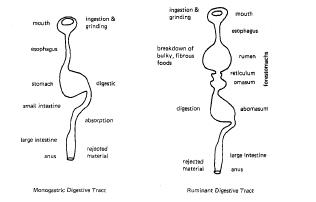Nutrients for Cattle
The use of adequate, well-balanced diets can maximize profits - or minimize losses - in a feeding program. An animal's diet must contain the essential nutrients in appropriate amounts and ratios. This paper outlines the nutrients which are basic to good cattle nutrition, and how well Alberta feeds succeed in supplying these nutrients. However, to better understand how feeds are used it is important to understand the digestion process in animals.
Digestive systems - In the monogastric or single stomached system, e.g. the pig and man, the digestive tract is essentially a muscular tube extending from the mouth to the anus. Its function is to ingest, grind, digest and absorb food, and to eliminate the waste products of the process.
In the monogastric, food is taken into the mouth and mixed with saliva which starts to break down the starch. The food then goes to the stomach where gastric juices break it down into its component nutrients. Further digestion occurs in the small intestine before nutrients are absorbed into the blood stream and carried to every cell in the body. The watery mass remaining is propelled by means of the muscular movement of the digestive tract into the large intestine which has the important function of absorbing water from it. The large intestine terminates in the anus through which waste products are expelled as feces or manure.

Figure 1. Diagramatic comparison of monogastric and ruminant digestive tracts.
Monogastrics eat both animal and vegetable foods. A monogastric animal usually chews its food before swallowing whereas the ruminant swallows its food after very little chewing. It is later regurgitated and chewed more thoroughly, hence the word ruminant: an animal which chews its cud.
The diet of a ruminant normally consists mainly of fibrous plant material which requires prolonged chewing, fermentation and soaking before its nutrients are available for digestion and absorption. The compartments in which this takes place are the forestomachs, of which there are three: the rumen, the reticulum, and the omasum. The stomach proper, corresponding to the simple monogastric stomach, is called the abomasum.
The rumen functions as a huge 275 litres (60 gal) fermentation vat in which the hay, straw, and other foodstuffs are processed for digestion in the true stomach. The microorganisms in the rumen derive their nutrients from the feed consumed by the cow, thereby allowing the cow to utilize high fibre materials such as hay and straw which cannot be digested by a single-stomached animal. The fibrous plant material is broken down by bacteria and protozoa into a mixture of volatile fatty acids (VFA), which are absorbed into the body through the rumen walls. The bacteria also make the B vitamins and can convert urea or ammonia from non-plant sources into protein.
In addition, the microorganisms pass along the digestive tract with the other food materials and are themselves digested to provide additional energy, high quality protein and other nutrients to the cow.
The reticulum acts in concert with the rumen and serves to trap foreign materials the animal may have swallowed, like wire or nails. The food passes from the rumen through the reticulum to the omasum where the food is ground between projections which radiate from the walls. It then proceeds to the abomasum where digestion proceeds much as it does in the monogastric.
Feeds for beef cattle must supply energy, protein, certain vitamins and minerals. Although different species have different nutritional requirements, there is one principle which applies to the nutritional requirements of all animals, that is, if ample amounts of all nutrients but one are fed, the level of that particular nutrient will limit performance.
The main components of food are water and dry matter. The dry matter consists of organic material and inorganic material.
Water is essential in the transport of metabolic products and wastes throughout the body, and for most chemical reactions in the body. The amount of water required varies with the amount of feed consumed, body size, species, and the surrounding temperature. However, if water intake declines, feed intake usually declines.
Energy
Animals require energy for maintenance, growth, work, and for the production of milk and wool. Feeds are evaluated in terms of the amount of energy an animal can obtain from them. The digestible energy (DE) is the gross (total) amount of energy in the hay and grain fed an animal less the amount lost in the feces. Energy is usually reported in megacalories (Mcal) per kilogram. (One kilocalorie is equal to 1,000 calories. One megacalorie is equal to 1,000,000 calories).
Amount of DE needed by an animal per day varies according to body size, weight gain, milk production, and work. The amount of energy required to maintain an animal for one day without loss of body weight is called the energy required for maintenance. Most symptoms of slight energy deficiency are not very noticeable: slightly reduced gains, less than maximum milk production and small increases in calving interval. The more severe the energy deficiency, the more noticeable are the symptoms described. Excess energy is stored as fat.
Table 1 gives the digestible energy values of some common feeds.
The most common energy source is from the carbohydrates contained in feeds. These are the sugars, starches, cellulose and hemicellulose which have been stored in plant tissues. Chemical reactions which take place in the animal release the energy in the feed (originally trapped from the sun by the plant) and convert it to other forms of energy which the animal can use.
Lipids are another energy source found in plants. They are fats and compounds closely related to them. They contain about two and a half times as much energy as carbohydrates.
Table 1. Average Energy and Protein Values of Some Alberta Feeds (Dry Basis)





